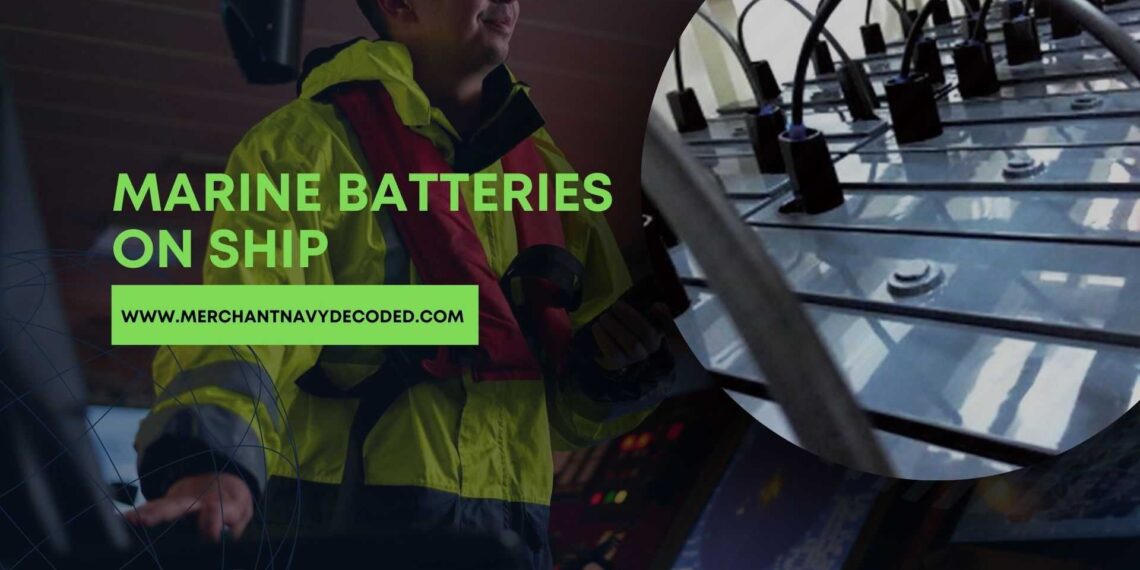Types of Marine Batteries and Their Uses
1:- Overview of Marine Batteries
Ship batteries are essential components of modern ships, powering a wide range of systems and equipment. From navigation and communication systems to emergency lighting and propulsion, batteries play a crucial role in ensuring the safe and efficient operation of a vessel. Here, we will learn the different types of batteries used onboard ships, their functions, advantages, and disadvantages.
2:- What is Battery?
A battery is a compact device that converts stored chemical energy into electrical power helping a wide range of devices to function. It consists of one or more electrochemical cells, each composed of a positive electrode (anode), a negative electrode (cathode), and an electrolyte. When connected to a circuit, the chemical reaction between the electrodes and the electrolyte generates an electrical current.
To learn about the Types of marine batteries, their charging procedure, maintenance and much more then check out our MEO Class 4 Excellence Course that will give you complete knowledge about the ship batteries and helps you to clear MEO Class 4.
3:- Types of Marine Batteries
3.1:- Primary Batteries on Ship
Primary batteries are designed for single use. After the reaction is complete the battery cannot be used again. Examples of primary batteries include alkaline, zinc-carbon, and lithium-ion batteries.
- Primary cells are used for low to moderately high-power drain applications. They have flat, button, or cylindrical configurations. In a primary cell, the chemical action eats away one of the electrodes, usually the negative electrode.
- When this occurs, the electrode or the entire cell may need to be replaced. In a galvanic cell, the zinc electrode and the liquid electrolyte are often the components that require replacement.
- Primary cells are used in computers, navigation equipment, standby power, and remote area use. Their high energy density and capacity, long shelf life, and freedom from recharging are important requisites in such systems.
- Remember that a cell is a single unit (of the source of supply) while a battery is a combination of two or more cells in series, parallel, or a series-parallel combination. This applies to both primary and secondary cells.
3.2:- Secondary Batteries on Ship
Secondary batteries, also known as rechargeable batteries, can be recharged after their energy has been depleted. This is achieved by reversing the chemical reaction that occurs during discharge.
- Secondary cells are sometimes known as wet cells. There are four basic types of wet cells:
- Lead-acid
- Nickel-cadmium
- Silver-zinc
- Silver-cadmium
- Various materials are used to create the electrolyte, cathode, and anode of different types of cells. These combinations determine the unique characteristics of each cell, making them suitable for specific applications. For instance, lead-acid batteries are well-suited for starting, lighting, and ignition (SLI) on ship.
- In secondary cells, the chemical reactions that occur during discharge alter the electrodes and electrolyte. However, these cells can be restored to their original state by passing an electric current through them in the opposite direction of the discharge current. A common example of secondary cells is the batteries used to start emergency generators on ships.
4:- Lead-Acid Battery – One of the Major used Batteries Onboard
4.1:- Battery Construction
- Plates: The battery contains a series of lead plates, alternating between positive (anode) and negative (cathode) plates.
- Electrolyte: The plates are immersed in an electrolyte solution, typically sulfuric acid diluted in water.
- Separator: A porous separator is placed between the positive and negative plates to prevent direct contact and short circuits.
4.2:- Charging Process of Lead Acid Batteries
- Chemical Reaction: During charging, an external electrical current is applied to the battery. This causes a chemical reaction at the electrodes.
- Positive Plate: At the positive plate (anode), lead sulfate (PbSO₄) is converted back into lead dioxide (PbO₂).
- Negative Plate: At the negative plate (cathode), lead sulfate is converted back into lead (Pb).
- Electrolyte: The sulfuric acid concentration increases as water is consumed in the reaction.
4.3:- Discharging Process
- Chemical Reaction: When the battery is connected to a load, a chemical reaction occurs.
- Positive Plate: Lead dioxide reacts with sulfuric acid to form lead sulfate and water.
- Negative Plate: Lead reacts with sulfuric acid to form lead sulfate and water.
- Electrolyte: The sulfuric acid concentration decreases as water is produced in the reaction.
4.4:- Battery State of Charge (SOC)
- Sulfation: The level of lead sulfate on the plates determines the battery’s state of charge. A fully charged battery has minimal lead sulfate.
- Battery Capacity: The maximum amount of electrical energy a battery can store is known as its capacity, often measured in ampere-hours (Ah).
4.5:- Care and Maintenance of Lead Acid Batteries
- Regular Charging and Discharging: It is essential to charge and discharge the battery periodically to maintain its health and performance.
- Avoid Deep Discharge: Never allow the battery’s voltage to drop below 1.8 volts to prevent permanent damage.
- Water Replacement: Replace lost water due to gassing with distilled water only to maintain the proper electrolyte level.
- Electrolyte Addition: If necessary, add only diluted sulfuric acid to the battery to restore the electrolyte concentration.
- Electrolyte Coverage: Ensure that the battery plates are always fully submerged in the electrolyte.
- Ventilation: Provide adequate ventilation in the area where batteries are charged to dissipate harmful gasses.
- Cleanliness and Dryness: Keep the battery clean from dust and foreign particles, and maintain a dry environment in the battery storage area.
- Equalization Charging: Occasionally perform equalization charging at a higher voltage to remove sulfation and restore battery capacity.
- Temperature Management: Avoid excessive temperatures above 45°C, as high temperatures can shorten the battery’s lifespan.
- Terminal Protection: Apply a thin layer of petroleum jelly to the battery terminals and links to prevent corrosion.
5:- Nickel Cadmium Battery [alkaline battery] on Ship

5.1:- Battery Construction and Chemistry
- Positive Electrode: Composed of nickel hydroxide and graphite.
- Negative Electrode: Consists of cadmium and iron.
- Electrolyte: A potassium hydroxide alkaline solution.
- Cell Voltage: Approximately 1.4 volts per cell.
- Battery Voltage: Typically, five cells are connected in series to produce around seven volts.
- Casing: Each cell is enclosed in a steel case.
- Arrangement: The cells are arranged in an interleaved configuration.
5.2:- Battery Packaging and Connection
- Packaging: The cells are mounted in wooden crates with spacing between them.
- Connection: The cells are connected in series to achieve the desired battery voltage.
5.3:- Battery Operation and Maintenance
- Charging: During charging, the nickel hydroxide plate becomes positively charged, while the cadmium plate becomes negatively charged.
- Oxygen Transfer: Oxygen is transferred between the plates during discharge without affecting the electrolyte’s specific gravity.
- Electrolyte Degradation: The specific gravity of the electrolyte gradually decreases over time.
- Electrolyte Replacement: The electrolyte should be replaced when its specific gravity falls below a certain level (approximately 1.160).
- Sealed Design: The battery is sealed, preventing gas release during charging.
- Cell Count: Alkaline batteries require a higher number of cells compared to lead-acid batteries to achieve the same voltage (approximately 67% more cells).
6:- Functions of Batteries Onboard Ships
Batteries serve a variety of functions on ships, including:
- Emergency power: Providing backup power for essential systems in case of a power outage.
- Propulsion: Powering electric propulsion systems or hybrid propulsion systems.
- Navigation and communication: Supplying power to navigation equipment, radios, and other communication systems.
- Lighting: Operating lights throughout the ship, including emergency lighting.
- Instrumentation: Providing power to various instruments and sensors.
- Life-saving equipment: powering emergency life-saving equipment such as searchlights and distress flares.
7:- Conclusion
Batteries play a vital role in the operation of modern ships, providing power for a wide range of systems and equipment. The choice of battery type depends on the specific requirements of the application, considering factors such as cost, performance, and environmental considerations.
Disclaimer :- The opinions expressed in this article belong solely to the author and may not necessarily reflect those of Merchant Navy Decoded. We cannot guarantee the accuracy of the information provided and disclaim any responsibility for it. Data and visuals used are sourced from publicly available information and may not be authenticated by any regulatory body. Reviews and comments appearing on our blogs represent the opinions of individuals and do not necessarily reflect the views of Merchant Navy Decoded. We are not responsible for any loss or damage resulting from reliance on these reviews or comments.
Reproduction, copying, sharing, or use of the article or images in any form is strictly prohibited without prior permission from both the author and Merchant Navy Decoded.



